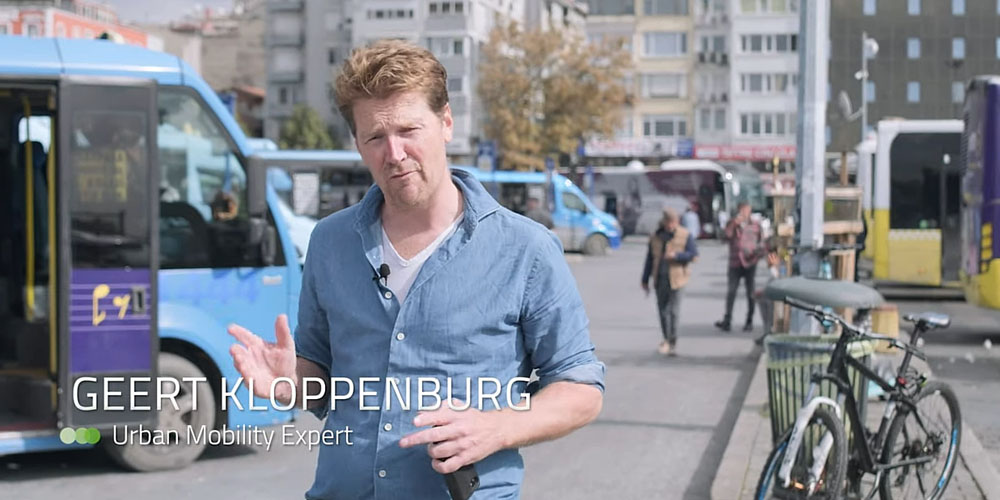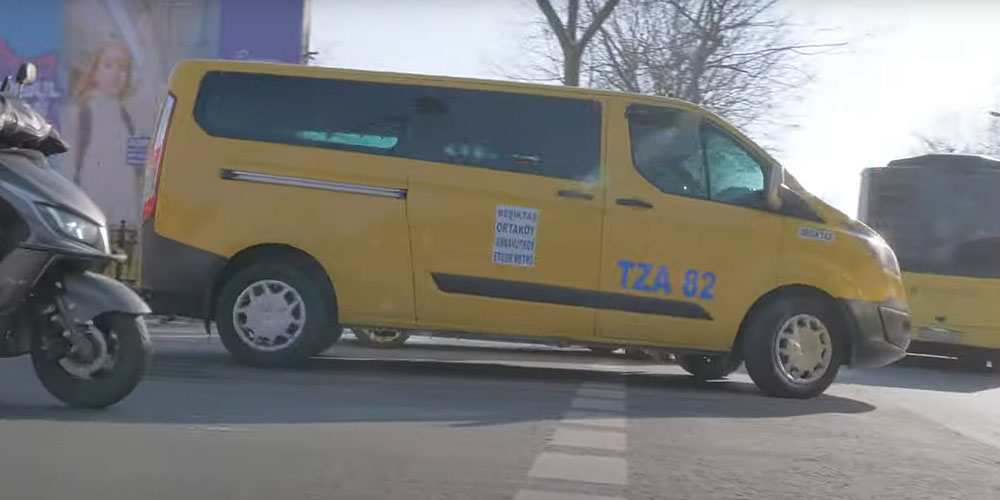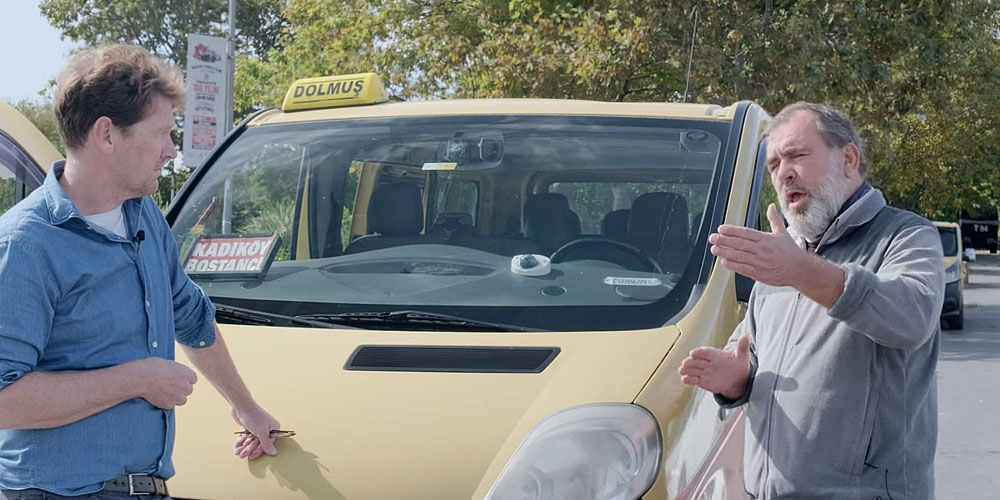“Vans, more vans; are they van-mad here?”
[Intro] In his role as EIT Urban Mobility expert, Geert Kloppenburg went to Istanbul to figure out the dolmuş system. It turned out even more interesting than he had thought: 5000 vans, servicing 20 per cent of the public transport in this metropolis with 16 million inhabitants. “Why do we not have this in other European cities? A system that is flexible, demand-driven and unsubsidised!”
Kloppenburg has been in Istanbul for three days and is starting to know his way around the public transport system. For the last part of his journey to the town hall, where he will be carrying out an interview, he wants to take one of those vans that transport 9 people, a dolmuş. Because he has finally figured out how it works. He flags down what he thinks is one of those vans, but it turns out to be a school bus of which the driver is friendly enough to stop for this westerner who is frantically waving his arms. All the children on the bus are rolling around with laughter. But where should he have gone then? How do all those inhabitants of Istanbul know this?
This scene, which eventually is not included in Kloppenburg’s video about his trip to Istanbul, is a good example of his struggle to ‘completely and utterly’ understand the dolmuş system. He has been mentioning the Turkish dolmuş vans for years as an example to follow. He used it in his book ‘De gulden snelweg’ (the golden highway), his vision for the future of public transport. The dolmuş system contains elements which remind him of the White Cart project of Luud Schimmelpennink, a member of the protest Provo movement in Amsterdam in the 1960s, who invented an alternative public transport system with electric carts. Kloppenburg is convinced that the dolmuş system offers opportunities for urban mobility, especially when using clean vehicles, but he had never actually researched the system in practice. So when, during a meeting of EIT Urban Mobility (the European initiative in the field of urban mobility) at the start of 2023, he got chatting to the head of transport for the Istanbul metropolitan area, responsible for transporting 16 million people, a plan was made: commissioned by EIT Mobility, Kloppenburg was to make a film about the dolmuş vans in Istanbul.
Willem Frederik Metselaar, director EIT Urban Mobility Hub West: ‘Dolmus has been around for a long time, but is also relatively unknown. That is why it is important to seriously investigate this system.’
Question: What attracted you so much about this system?
 “The flexibility, the flagging down, the absence of a timetable. That also more or less summed up what I knew about it. It made me think of old-fashioned taxis, but at the same time it’s a form of public transport, which was a trigger for me. Is it really a form of public transport? Who drives these vans? And who decides their itinerary? Who decides how much you pay to use it? Is it possible to implement this in other European cities?”
“The flexibility, the flagging down, the absence of a timetable. That also more or less summed up what I knew about it. It made me think of old-fashioned taxis, but at the same time it’s a form of public transport, which was a trigger for me. Is it really a form of public transport? Who drives these vans? And who decides their itinerary? Who decides how much you pay to use it? Is it possible to implement this in other European cities?”
Research
What followed was 7 months of research, video conferences and telephone conversations. Kloppenburg sent questions and requests to Istanbul, received notes, PowerPoint presentations, plans and maps, spoke to 30 Turkish public servants during a Zoom call, and so on, and so on. At the same time, the list with questions was growing.
“Three days before I left, the Istanbul transport department sent me a very short document, which very clearly stated: ‘There are 5,710 minibuses (max. 16 people) and dolmuş vans (max. 9 people), 170 lines and 460 routes, transporting 1.2 million passengers per day. These vans constitute 20 percent of public transport in Istanbul.’ 20 percent! That is massive. ‘In addition, there are 66,000 school and staff buses, and 20,000 taxis.’
So then you ask yourself: why do they have so many vans? Are the van-mad? Why did they not construct metro lines, like in Paris? And then you read about the risk of earthquakes, about the poverty after the Second World War, about how to solve things in a flexible way – the history of a city also determines the way certain systems are developed.”
The Sustainable Uban Mobility Plan or SUMP provided Kloppenburg with Istanbul’s vision of the future in terms of minibuses and dolmuş. Kloppenburg: “Comparing SUMPs is something I do regularly, that is more or less what my job is about. So where do those minibuses and dolmuş vans appear in here? They hardly do. Fascinating, this is all about railway tracks again. It really is the same old story everywhere. All those councillors and ministers always want train tracks, or a big bus because that is what they consider to be public transport. What are the plans for dolmuş vans and minibuses for 2040? The only thing they mention is integration with the Istanbul card, which is in fact a very good idea.”
What is the itinerary of those vans?
 After all that preliminary research, it is time to visit Istanbul in October. As always, Kloppenburg arrives in town three days before his first interview. Now, where to find those dolmuş vans and minibuses? He sees blues vans, yellow vans, all sorts of vans, but what is what? Kloppenburg: “In the end, I just got on one, thinking ‘I’ll soon find out’. And it went in the complete opposite direction of what I had intended. I didn’t understand how much I had to pay, I didn’t understand which lines there were, where the starting points were – I quite simply didn’t understand one iota.” He did not have a map of the network. Eventually, he figured out that the lines could be found on Google maps.
After all that preliminary research, it is time to visit Istanbul in October. As always, Kloppenburg arrives in town three days before his first interview. Now, where to find those dolmuş vans and minibuses? He sees blues vans, yellow vans, all sorts of vans, but what is what? Kloppenburg: “In the end, I just got on one, thinking ‘I’ll soon find out’. And it went in the complete opposite direction of what I had intended. I didn’t understand how much I had to pay, I didn’t understand which lines there were, where the starting points were – I quite simply didn’t understand one iota.” He did not have a map of the network. Eventually, he figured out that the lines could be found on Google maps.
One day before the first interview, Kloppenburg was in a slight panic: how was he supposed to ask good questions if he still had so much trouble understanding this system? “So I called my Turkish camera man and asked him if he could come and join me. Because he spoke very good English. So I made one entire journey with him and he explained to me how the whole system works. He uses it a lot himself, as does his family. Everyone, old, young, poor or rich, uses dolmuş vans.”
During this journey, they had a long conversation with a driver. “He told me that they scale up and down at their own initiative. Meaning that if it’s busy, another van is added.” The drivers are self-employed. The rates are set by the government. So the money is for the driver, but the rates, normal public transport rates, are set by the government. What did the driver think of that? “He said that actually, the cooperation works really well. As an outsider, you would think that those drivers would want the rates to go up, but that taxi entrepreneur said: ‘I don’t want the rates to go up, because that would make me lose too many customers.’ What is a problem now however, is the staggering inflation, causing the petrol price to skyrocket. The drivers in the regular public transport network are not effected by this, they are all employees.”
But the dolmuş drivers are generally self-employed; if they are ill, they call a colleague. Kloppenburg: “It is very similar to the TCA taxi centre in Amsterdam: one car, driven by four drivers. What makes it special, is that they are part of the public transport system. That really is unique. The government sets the rate and decides the itinerary of the line.”
We Dutch being arrogant, we quickly think that the dolmuş system only works in Turkey because they don’t earn a lot of money over there. Kloppenburg: “But that is not the case at all, those drivers earn a normal wage. If you were to compare it to the Dutch situation, they earn a normal drivers’ wage as negotiated by the Dutch trade union.”
Kloppenburg and his camera team film for ten days. He visits the farthest corners of Istanbul, the places not a single tourist goes. He sees minibuses coming and going at one of the stops of Istanbul’s impressive Bus Rapid Transit line, the metro bus. He interviews the head of the dolmuş system, who is actually quite surprised that a Dutchman has come all the way to Turkey to look at a system which the Turks don’t find all that special and consider a bit old-fashioned even. He crosses the city, on foot, by bike, by public transport, by car. And he discovers the strength of the metro bus which crosses the metropolis fast and frequently on its dedicated bus lanes, servicing 9 percent of all public transport with just a single line.

Question: What are the big advantages of the dolmuş system?
Kloppenburg: “It is a system that works as a feeder for, for example, the metro bus and the train, but it also works as a stand-alone system. One line often branches out to become three lines further down. The dolmuş van can stop anywhere it likes. The fact that it is so ramified is one of the big strengths of this system, including for the elderly, for example, who have difficulty walking. The system is nearly door-to-door. All the addresses on a line are stops. And if you see how many lines there are, and how many addresses you thus reach, that makes an incredibly ramified system.”
Another big advantage is the flexibility. Kloppenburg: “The whole network could start using different streets tomorrow. That’s something that is impossible with railway tracks. And the vehicles are flexible: more vans, less vans. You can very easily scale up or scale down as needed.”
At the end of the film, Kloppenburg concludes that this dolmuş system is interesting for other European cities. “It is part of the public transport system, once the Istanbul Card has been integrated you can use the whole public transport network with just one card, and the system is not subsidised (there is no cash-out system). Generally, public transport requires public investments or a subsidy, but this system is self-sufficient with the rates and itineraries still being determined by the government.” Those are all advantages, which will increase even further if the system were to be improved at certain points. Kloppenburg: “Now just imagine that we combine this system with clean vehicles and more space on the road through dedicated lanes – that is when we are really cooking on gas, creating a system everybody has been waiting for.”
KB
Part two: Why the dolmuş system would be a suitable solution for European cities, such as Amsterdam.
